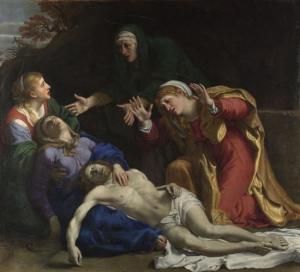The Dead Christ Mourned
The Dead Christ Mourned (‘The Three Maries)
Annibale Carracci 1604.
3’ 4” x 3’ Oil on canvas.
Now in the National Gallery, London.
Compared to an earlier Pieta, Annibale Carracci’s mood in The Dead Christ Mourned has shifted dramatically. Every figure in the composition is in a state of despair. The lighting has become more dramatic to the point of a Caravaggesque tenebrism.
Annibale Carracci was known to be a depressed man. This is what prevented the Farnese Gallery from getting done in a timely manner. Toward the end of his life, it started to show in his work. Once inspired by the peaceful death in Michelangelo’s Pieta (1498), Carracci’s Dead Christ appears to be very dead, and everyone around Him believes this is so. There does not appear to be any hope of resurrection in the limp Christ, whereas Michelangelo’s seems to be merely asleep.
Carracci’s mode of painting shifted from Correggio and Leonardo da Vinci inspired sfumto to a stark chiaroscuro similar in intensity to Caravaggio’s later works (being painted around the same time as this one). There is little sense of depth as there was in Carracci’s early works. A few trees are visible in the background, but the action is occurring right up front.
There is a circular motion about the painting. Christ lays limp and lifeless, head tossed back. The woman holding him in her lap (the Madonna?) mimics his pose as she has fainted. Another woman tries to hold Mary up, while looking at the woman standing above Christ to our right. This woman, along with the woman to the right of her, look devastatingly at Christ, and the cycle starts over again. There is a sense of never ending devastation with a lack of hint to the Resurrection here that traps one into believing this is a utterly catastrophic scene.
